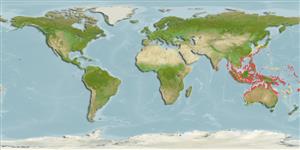Common names from other countries
Environment: milieu / climate zone / depth range / distribution range
Ecologia
marino; salmastro associati a barriera corallina; distribuzione batimetrica 1 - 25 m (Ref. 9407). Tropical
Indo-West Pacific: India eastward through Indonesia to New Guinea, northward to southern Japan, southward to northern Australia.
Size / Peso / Age
Maturity: Lm ? range ? - ? cm
Max length : 45.0 cm SL maschio/sesso non determinato; (Ref. 48637)
Spine dorsali (totale) : 0; Raggi dorsali molli (totale) : 10; Spine anali: 0; Raggi anali molli: 9 - 10. Body covered with prickles. White lines encircling eye (Ref. 559).
Occurs in shallow water reefs near sand or seaweed areas. Also found in estuaries and protected muddy bays; juveniles in mangroves and entering the lower reaches of streams (Ref. 9407, 48637). Solitary (Ref. 90102). Adults at moderate depths, often laying on the mud during the day (Ref. 48637).
Life cycle and mating behavior
Maturities | Riproduzione | Spawnings | Egg(s) | Fecundities | Larve
Masuda, H., K. Amaoka, C. Araga, T. Uyeno and T. Yoshino, 1984. The fishes of the Japanese Archipelago. Vol. 1. Tokai University Press, Tokyo, Japan. 437 p. (text). (Ref. 559)
IUCN Red List Status (Ref. 130435)
CITES (Ref. 128078)
Not Evaluated
Threat to humans
Harmless
Human uses
Pesca: di nessun interesse
Strumenti
Special reports
Download XML
Fonti Internet
Estimates based on models
Preferred temperature (Ref.
115969): 25.1 - 29.3, mean 28.6 (based on 2442 cells).
Phylogenetic diversity index (Ref.
82804): PD
50 = 0.5000 [Uniqueness, from 0.5 = low to 2.0 = high].
Bayesian length-weight: a=0.02951 (0.01562 - 0.05576), b=2.89 (2.73 - 3.05), in cm Total Length, based on LWR estimates for this species & Genus-body shape (Ref.
93245).
Trophic level (Ref.
69278): 3.4 ±0.5 se; based on size and trophs of closest relatives
Resilienza (Ref.
120179): Medio, tempo minimo di raddoppiamento della popolazione 1.4 - 4.4 anni (Preliminary K or Fecundity.).
Fishing Vulnerability (Ref.
59153): Moderate vulnerability (42 of 100).
